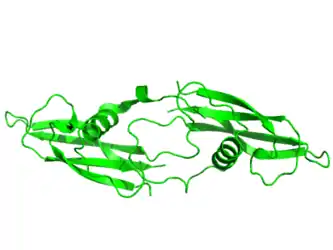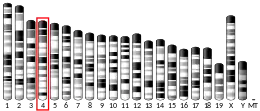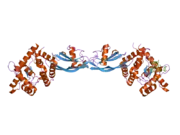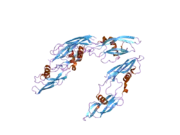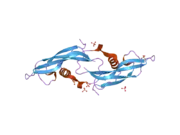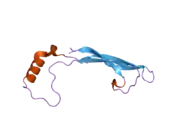Artemin
Artemin, also known as enovin or neublastin, is a protein that in humans is encoded by the ARTN gene.[5][6]
Function
Artemin is a neurotrophic factor in the glial cell line-derived neurotrophic factor family of ligands which are a group of ligands within the TGF-beta superfamily of signaling molecules. GDNFs are unique in having neurotrophic properties and have potential use for gene therapy in neurodegenerative disease. Artemin has been shown in culture to support the survival of a number of peripheral neuron populations and at least one population of dopaminergic CNS neurons. Its role in the PNS and CNS is further substantiated by its expression pattern in the proximity of these neurons. This protein is a ligand for the RET receptor and uses GFR-alpha 3 as a coreceptor.[5]
Role in Axonal Development
Artemin, along with other GDNF family of ligands, has been implicated in the structural development and plasticity of several types of neurons, including ventral mesencephalic dopaminergic neurons.[7] Artemin promotes the survival of newly differentiated neurons after they have undergone terminal mitosis. Artemin has also been found to support the survival neurons in later stages of development and can enhance neuron growth better than neural growth factor during later stages of development.[8] Artemin plays an important role in migration, proliferation, and differentiation of sympathetic neurons during development. However, during target innervation, sympathetic neurons become dependent on neural growth factor for survival support.[9]
Unlike other secreted guidance cues during development, artemin acts solely as a chemoattractant and never acts as a chemorepellent.[10] Artemin is expressed in smooth muscle cells and secreted along blood vessels and in cells near sympathetic axonal projections so that the sympathetic axons can reach their target tissue cells. [10]
References
- GRCh38: Ensembl release 89: ENSG00000117407 - Ensembl, May 2017
- GRCm38: Ensembl release 89: ENSMUSG00000028539 - Ensembl, May 2017
- "Human PubMed Reference:". National Center for Biotechnology Information, U.S. National Library of Medicine.
- "Mouse PubMed Reference:". National Center for Biotechnology Information, U.S. National Library of Medicine.
- "Entrez Gene: artemin".
- Baloh RH, Tansey MG, Lampe PA, Fahrner TJ, Enomoto H, Simburger KS, et al. (December 1998). "Artemin, a novel member of the GDNF ligand family, supports peripheral and central neurons and signals through the GFRalpha3-RET receptor complex". Neuron. 21 (6): 1291–302. doi:10.1016/S0896-6273(00)80649-2. PMID 9883723. S2CID 18633359.
- Zihlmann KB, Ducray AD, Schaller B, Huber AW, Krebs SH, Andres RH, et al. (December 2005). "The GDNF family members neurturin, artemin and persephin promote the morphological differentiation of cultured ventral mesencephalic dopaminergic neurons". Brain Research Bulletin. 68 (1–2): 42–53. doi:10.1016/j.brainresbull.2004.10.012. PMID 16325003. S2CID 31594656.
- Andres R, Forgie A, Wyatt S, Chen Q, de Sauvage FJ, Davies AM (October 2001). "Multiple effects of artemin on sympathetic neurone generation, survival and growth". Development. 128 (19): 3685–95. PMID 11585795.
- Airaksinen MS, Saarma M (May 2002). "The GDNF family: signalling, biological functions and therapeutic value". Nature Reviews. Neuroscience. 3 (5): 383–94. doi:10.1038/nrn812. PMID 11988777. S2CID 2480120.
- Honma Y, Araki T, Gianino S, Bruce A, Heuckeroth R, Johnson E, Milbrandt J (July 2002). "Artemin is a vascular-derived neurotropic factor for developing sympathetic neurons". Neuron. 35 (2): 267–82. doi:10.1016/s0896-6273(02)00774-2. PMID 12160745. S2CID 8104679.
Further reading
- Rosenblad C, Grønborg M, Hansen C, Blom N, Meyer M, Johansen J, et al. (February 2000). "In vivo protection of nigral dopamine neurons by lentiviral gene transfer of the novel GDNF-family member neublastin/artemin". Molecular and Cellular Neurosciences. 15 (2): 199–214. doi:10.1006/mcne.1999.0817. PMID 10673327. S2CID 1378559.
- Zhu DL, Luo DL, Luo G, Wang B, Gao JM (March 2009). "[Artemin and GFRalpha3 expressions and their relevance to perineural invasiveness and metastasis of pancreatic carcinoma]". Nan Fang Yi Ke da Xue Xue Bao = Journal of Southern Medical University. 29 (3): 428–32. PMID 19304517.
- Silvian L, Jin P, Carmillo P, Boriack-Sjodin PA, Pelletier C, Rushe M, et al. (June 2006). "Artemin crystal structure reveals insights into heparan sulfate binding". Biochemistry. 45 (22): 6801–12. doi:10.1021/bi060035x. PMID 16734417.
- Pandey V, Qian PX, Kang J, Perry JK, Mitchell MD, Yin Z, et al. (March 2010). "Artemin stimulates oncogenicity and invasiveness of human endometrial carcinoma cells". Endocrinology. 151 (3): 909–20. doi:10.1210/en.2009-0979. PMID 20118197.
- Masure S, Geerts H, Cik M, Hoefnagel E, Van Den Kieboom G, Tuytelaars A, et al. (December 1999). "Enovin, a member of the glial cell-line-derived neurotrophic factor (GDNF) family with growth promoting activity on neuronal cells. Existence and tissue-specific expression of different splice variants". European Journal of Biochemistry. 266 (3): 892–902. doi:10.1046/j.1432-1327.1999.00925.x. PMID 10583383.
- Fernandez RM, Ruiz-Ferrer M, Lopez-Alonso M, Antiñolo G, Borrego S (November 2008). "Polymorphisms in the genes encoding the 4 RET ligands, GDNF, NTN, ARTN, PSPN, and susceptibility to Hirschsprung disease". Journal of Pediatric Surgery. 43 (11): 2042–7. doi:10.1016/j.jpedsurg.2008.05.018. PMID 18970938.
- Ceyhan GO, Schäfer KH, Kerscher AG, Rauch U, Demir IE, Kadihasanoglu M, et al. (May 2010). "Nerve growth factor and artemin are paracrine mediators of pancreatic neuropathy in pancreatic adenocarcinoma". Annals of Surgery. 251 (5): 923–31. doi:10.1097/SLA.0b013e3181d974d4. PMID 20395845. S2CID 6581279.
- Kang J, Perry JK, Pandey V, Fielder GC, Mei B, Qian PX, et al. (May 2009). "Artemin is oncogenic for human mammary carcinoma cells". Oncogene. 28 (19): 2034–45. doi:10.1038/onc.2009.66. PMID 19363524.
- Wang X, Baloh RH, Milbrandt J, Garcia KC (June 2006). "Structure of artemin complexed with its receptor GFRalpha3: convergent recognition of glial cell line-derived neurotrophic factors". Structure. 14 (6): 1083–92. doi:10.1016/j.str.2006.05.010. PMID 16765900.
- Quartu M, Serra MP, Manca A, Mascia F, Follesa P, Del Fiacco M (April 2005). "Neurturin, persephin, and artemin in the human pre- and full-term newborn and adult hippocampus and fascia dentata". Brain Research. 1041 (2): 157–66. doi:10.1016/j.brainres.2005.02.007. PMID 15829225. S2CID 35298612.
- Otsuki K, Uchida S, Watanuki T, Wakabayashi Y, Fujimoto M, Matsubara T, et al. (October 2008). "Altered expression of neurotrophic factors in patients with major depression". Journal of Psychiatric Research. 42 (14): 1145–53. doi:10.1016/j.jpsychires.2008.01.010. PMID 18313696.
- Naveilhan P, Baudet C, Mikaels A, Shen L, Westphal H, Ernfors P (February 1998). "Expression and regulation of GFRalpha3, a glial cell line-derived neurotrophic factor family receptor". Proceedings of the National Academy of Sciences of the United States of America. 95 (3): 1295–300. Bibcode:1998PNAS...95.1295N. doi:10.1073/pnas.95.3.1295. PMC 18749. PMID 9448325.
External links
- artemin+protein,+human at the US National Library of Medicine Medical Subject Headings (MeSH)
- Human ARTN genome location and ARTN gene details page in the UCSC Genome Browser.
- Human NBN genome location and NBN gene details page in the UCSC Genome Browser.
This article incorporates text from the United States National Library of Medicine, which is in the public domain.
